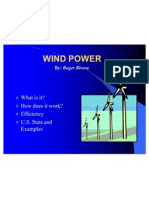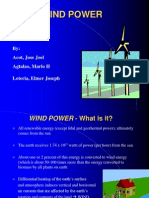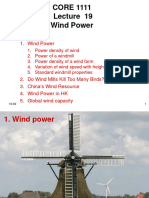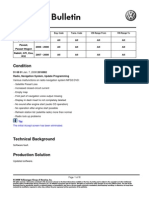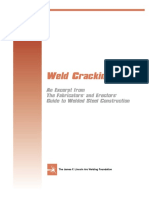Wind Power What Is It?
Wind Power What Is It?
Uploaded by
Arriane Pineda FernandezCopyright:
Available Formats
Wind Power What Is It?
Wind Power What Is It?
Uploaded by
Arriane Pineda FernandezOriginal Title
Copyright
Available Formats
Share this document
Did you find this document useful?
Is this content inappropriate?
Copyright:
Available Formats
Wind Power What Is It?
Wind Power What Is It?
Uploaded by
Arriane Pineda FernandezCopyright:
Available Formats
WIND POWER What is it?
All renewable energy (except tidal and geothermal power), ultimately comes from the sun The earth receives 1.74 x 1017 watts of power (per hour) from the sun About one or 2 percent of this energy is converted to wind energy (which is about 50-100 times more than the energy converted to biomass by all plants on earth Differential heating of the earths surface and atmosphere induces vertical and horizontal air currents that are affected by the earths rotation and contours of the land WIND. ~ e.g.: Land Sea Breeze Cycle Winds are influenced by the ground surface at altitudes up to 100 meters. Wind is slowed by the surface roughness and obstacles. When dealing with wind energy, we are concerned with surface winds. A wind turbine obtains its power input by converting the force of the wind into a torque (turning force) acting on the rotor blades. The amount of energy which the wind transfers to the rotor depends on the density of the air, the rotor area, and the wind speed. The kinetic energy of a moving body is proportional to its mass (or weight). The kinetic energy in the wind thus depends on the density of the air, i.e. its mass per unit of volume. In other words, the "heavier" the air, the more energy is received by the turbine. at 15 Celsius air weighs about 1.225 kg per cubic meter, but the density decreases slightly with increasing humidity.
A typical 600 kW wind turbine has a rotor diameter of 43-44 meters, i.e. a rotor area of some 1,500 square meters. The rotor area determines how much energy a wind turbine is able to harvest from the wind. Since the rotor area increases with the square of the rotor diameter, a turbine which is twice as large will receive 22 = 2 x 2 = four times as much energy.
To be considered a good location for wind energy, an area needs to have average annual wind speeds of at least 12 miles per hour.
WINDMILL DESIGN A Windmill captures wind energy and then uses a generator to convert it to electrical energy. The design of a windmill is an integral part of how efficient it will be. When designing a windmill, one must decide on the size of the turbine, and the size of the generator. Wind Turbines LARGE TURBINES: Able to deliver electricity at lower cost than smaller turbines, because foundation costs, planning costs, etc. are independent of size. Well-suited for offshore wind plants. In areas where it is difficult to find sites, one large turbine on a tall tower uses the wind extremely efficiently.
SMALL TURBINES: Local electrical grids may not be able to handle the large electrical output from a large turbine, so smaller turbines may be more suitable. High costs for foundations for large turbines may not be economical in some areas. Landscape considerations
Wind Turbines: Number of Blades Most common design is the three-bladed turbine. The most important reason is the stability of the turbine. A rotor with an odd number of rotor blades (and at least three blades) can be considered to be similar to a disc when calculating the dynamic properties of the machine. A rotor with an even number of blades will give stability problems for a machine with a stiff structure. The reason is that at the very moment when the uppermost blade bends backwards, because it gets the maximum power from the wind, the lowermost blade passes into the wind shade in front of the tower.
Wind Turbine Generators
Wind power generators convert wind energy (mechanical energy) to electrical energy. The generator is attached at one end to the wind turbine, which provides the mechanical energy. At the other end, the generator is connected to the electrical grid. The generator needs to have a cooling system to make sure there is no overheating.
SMALL GENERATORS: Require less force to turn than a larger ones, but give much lower power output. Less efficient
i.e.. If you fit a large wind turbine rotor with a small generator it will be producing electricity during many hours of the year, but it will capture only a small part of the energy content of the wind at high wind speeds. LARGE GENERATORS: Very efficient at high wind speeds, but unable to turn at low wind speeds.
i.e.. If the generator has larger coils, and/or a stronger internal magnet, it will require more force (mechanical) to start in motion. U.S. Wind Energy Use The U.S. currently has more than 1,600 MW of installed capacity and produces about 3 billion KWh of electricity each year. This is enough to meet the annual residential needs of 1 million people. More than 90 percent of this power is produced by three wind farms in California (Altamont Pass, Tehachapi and Palm Springs).
Striking Facts About Wind Energy Potential in the US The U.S. contains enough useable wind resource to produce more electricity than the nation currently uses. The majority of this usable resource is in the Great Plains region. North Dakota alone has enough suitable wind resource to supply 36 percent of the electricity consumed in the U.S. In addition, development of major global wind energy markets could significantly impact jobs recent studies show that each billion kilowatt-hours of annual wind energy generation creates between 440 to 460 jobs.
Advantages of Wind Power The wind blows day and night, which allows windmills to produce electricity throughout the day. (Faster during the day) Energy output from a wind turbine will vary as the wind varies, although the most rapid variations will to some extent be compensated for by the inertia of the wind turbine rotor. Wind energy is a domestic, renewable source of energy that generates no pollution and has little environmental impact. Up to 95 percent of land used for wind farms can also be used for other profitable activities including ranching, farming and forestry. The decreasing cost of wind power and the growing interest in renewable energy sources should ensure that wind power will become a viable energy source in the United States and worldwide. Disadvantages of Wind Power The wind is not always predictable - some days have no wind. Suitable areas for wind farms are often near the coast, where land is expensive. Some people feel that covering the landscape with these towers is unsightly. Can kill birds - migrating flocks tend to like strong winds. However, this is rare, and we tend not to build wind farms on migratory routes anyway. Can affect television reception if you live nearby. Can be noisy. Wind generators have a reputation for making a constant, low, "swooshing" noise day and night, which can drive you nuts.
Wind Power and the Environment Wind Turbines and the Landscape - Large turbines dont turn as fast attract less attention - City dwellers dwell on the attention attracted by windmills Sound from Wind Turbines - Increasing tip speed less sound - The closest neighbor is usually 300 m experiences almost no noise Birds often collide with high voltage overhead lines, masts, poles, and windows of buildings.
They are also killed by cars in traffic. However, birds are seldom bothered by wind turbines. The only known site with bird collision problems is located in the Altamont Pass in California. Danish Ministry of the Environment study revealed that power lines are a much greater danger to birds than the wind turbines. Some birds even nest on cages on Wind Towers.
Prepared by: Geralyn S. Luat
You might also like
- Sign Up To English 2 Guia DocenteDocument90 pagesSign Up To English 2 Guia DocenteElena100% (1)
- WindmillDocument23 pagesWindmillManav KohliNo ratings yet
- Wind Power: What Is It? How Does It Work? Efficiency U.S. Stats and ExamplesDocument23 pagesWind Power: What Is It? How Does It Work? Efficiency U.S. Stats and ExamplesLalit SharmaNo ratings yet
- Wind PowerDocument23 pagesWind PowerNur CaatoNo ratings yet
- Wind Power: What Is It? How Does It Work? EfficiencyDocument13 pagesWind Power: What Is It? How Does It Work? EfficiencyAkshay GatkalNo ratings yet
- Wind PowerDocument23 pagesWind PowerDhawal DesaiNo ratings yet
- WINDPOWERDocument18 pagesWINDPOWERChanning TatumNo ratings yet
- Pertemuan 5 TTL 17maret2023Document131 pagesPertemuan 5 TTL 17maret2023Ali PrasetyoNo ratings yet
- WINDPOWERDocument74 pagesWINDPOWERimran.khanNo ratings yet
- Wind EnergyDocument36 pagesWind EnergyMohamed Al-Odat100% (1)
- Wind Energy: Process of Wind CreationDocument4 pagesWind Energy: Process of Wind CreationmariyaNo ratings yet
- Final Ppt-Wind PowerDocument33 pagesFinal Ppt-Wind Powerkit1016513010No ratings yet
- Wind Power: By: Juan MoraDocument9 pagesWind Power: By: Juan MoraSA SANo ratings yet
- What Is Wind?Document10 pagesWhat Is Wind?kyrie1163311No ratings yet
- Wind Power StationDocument22 pagesWind Power StationSwaraj TodankarNo ratings yet
- Wind Power: - What Is It? - How Does It Work? - Efficiency - U.S. Stats and ExamplesDocument5 pagesWind Power: - What Is It? - How Does It Work? - Efficiency - U.S. Stats and ExamplesrbanandNo ratings yet
- Wind EnergyDocument18 pagesWind EnergyShayan KashifNo ratings yet
- Alternate Energy Activities: A Look at Wind PowerDocument64 pagesAlternate Energy Activities: A Look at Wind PowerK Venkat EshNo ratings yet
- WindDocument24 pagesWindShiva Prasad KsNo ratings yet
- Wind PowerDocument40 pagesWind PowerPrajwal Shivareddy100% (1)
- Final PPT Wind PowerDocument33 pagesFinal PPT Wind PowerBikram singh100% (2)
- Wind EnergyDocument27 pagesWind EnergyAnkush Yadav100% (1)
- Wind Power PlantDocument8 pagesWind Power Plantshrey1993No ratings yet
- PPT5 Wind EnergyDocument32 pagesPPT5 Wind EnergyWinston LibangaNo ratings yet
- E-Note_2277_Content_Document_20240904095238AMDocument29 pagesE-Note_2277_Content_Document_20240904095238AMkustagoknuNo ratings yet
- 12 Wind EnergyDocument34 pages12 Wind Energyabubakar bajwaNo ratings yet
- Unit-3 WindDocument35 pagesUnit-3 Wind2k21cse093No ratings yet
- CH 7 Wind EnergyDocument8 pagesCH 7 Wind EnergyscharichNo ratings yet
- Wind EnergyDocument31 pagesWind EnergySeek seekNo ratings yet
- Windmill ReportDocument44 pagesWindmill Reportapi-3730369100% (1)
- Chapter 3 Wind EnergyDocument77 pagesChapter 3 Wind EnergyBewnet GetachewNo ratings yet
- Presentation 1Document27 pagesPresentation 1Hiren vaghaniNo ratings yet
- Wind EnergyDocument4 pagesWind EnergyAhmed BoumalekNo ratings yet
- Wind Energy: Reporters: Contreras, Kenneth Clyde Gaudia, Christian Tagolimot, Bryan Paul Tarosa, Regelle ME 5-CDocument19 pagesWind Energy: Reporters: Contreras, Kenneth Clyde Gaudia, Christian Tagolimot, Bryan Paul Tarosa, Regelle ME 5-CCarol Ann D. SanoNo ratings yet
- Wind Energy (DAPINDER)Document24 pagesWind Energy (DAPINDER)Piyush Kumar RaiNo ratings yet
- Franklin Coyle-Introduction To Wind Power - World Technologies (2011)Document202 pagesFranklin Coyle-Introduction To Wind Power - World Technologies (2011)Theodore Teddy JNo ratings yet
- Lecture 19 - Wind PowerDocument38 pagesLecture 19 - Wind PowerLi RanNo ratings yet
- Sonu Wind EnergyDocument20 pagesSonu Wind EnergySonu ChahalNo ratings yet
- WindDocument39 pagesWindahmad_shafieiNo ratings yet
- How Wind Turbines WorkDocument11 pagesHow Wind Turbines Worktohz2aNo ratings yet
- Windenergy 210626034246Document25 pagesWindenergy 210626034246DAVIT KAZARASHVILINo ratings yet
- Wind TurbinDocument9 pagesWind TurbinSarah SadiNo ratings yet
- Wind Power Presentation 2019Document55 pagesWind Power Presentation 2019Chami Liyanage100% (1)
- Wind and Other Renewable Energy SourcesDocument25 pagesWind and Other Renewable Energy SourcesVarun Singh ChandelNo ratings yet
- Oral Report - Wind EnergyDocument40 pagesOral Report - Wind EnergyAllen Jerry AriesNo ratings yet
- Alternative Energy Wind EnergyDocument9 pagesAlternative Energy Wind EnergyKamran KhanNo ratings yet
- Wind and SolarDocument8 pagesWind and Solarsr_muleNo ratings yet
- 18ME651 NCES Module-4Document49 pages18ME651 NCES Module-4ShebinNo ratings yet
- Iv - Wind EnergyDocument16 pagesIv - Wind Energyckrishna625No ratings yet
- rohini_46560696652Document6 pagesrohini_46560696652Navi NaviNo ratings yet
- ELG4126 Introductioto WindDocument38 pagesELG4126 Introductioto WindAnikesh DessaiNo ratings yet
- L11 - Energy Sources - WindDocument22 pagesL11 - Energy Sources - Wind윤조호No ratings yet
- Windmills 1Document17 pagesWindmills 1umamaddineniNo ratings yet
- Tilahun Hydro 4 THDocument17 pagesTilahun Hydro 4 THMekonenNo ratings yet
- Wind Power SeminarDocument15 pagesWind Power SeminarDeepak KumarNo ratings yet
- Electricity for the farm Light, heat and power by inexpensive methods from the water wheel or farm engineFrom EverandElectricity for the farm Light, heat and power by inexpensive methods from the water wheel or farm engineRating: 5 out of 5 stars5/5 (1)
- VW TB 91-08-01Document8 pagesVW TB 91-08-01حسام عبداويNo ratings yet
- GA & CK QueDocument281 pagesGA & CK QueBhavesh PadayaNo ratings yet
- CV AnshumanDocument2 pagesCV AnshumanAnshumanNo ratings yet
- Managing People For Service AdvantageDocument24 pagesManaging People For Service AdvantageathulkannanNo ratings yet
- Dual Write - Troubleshooting_003_Mapping setupDocument8 pagesDual Write - Troubleshooting_003_Mapping setupbabu thumNo ratings yet
- Phases: Covering Your Tracks: - Steganography - Event Logs AlterationDocument9 pagesPhases: Covering Your Tracks: - Steganography - Event Logs AlterationhiyuNo ratings yet
- Udupi Ramachandra RaoDocument5 pagesUdupi Ramachandra Raodroy21No ratings yet
- 2.1 Cambodia-PresentationMRC Lao FinalDocument26 pages2.1 Cambodia-PresentationMRC Lao FinalSaravornNo ratings yet
- Analog Devices Engineering UniversityDocument5 pagesAnalog Devices Engineering UniversityjeevarajanmkNo ratings yet
- REH984b 05a PDFDocument17 pagesREH984b 05a PDFcritestachNo ratings yet
- Manufacturing StrategyDocument2 pagesManufacturing StrategyProcusto LNo ratings yet
- TRFDocument65 pagesTRFPrabagaran PrtNo ratings yet
- CTA Plumbing Code of Practice PDFDocument24 pagesCTA Plumbing Code of Practice PDFOwenNo ratings yet
- Hexagon Manufacturing Solutions Final ReportDocument119 pagesHexagon Manufacturing Solutions Final ReportCayure DiegoNo ratings yet
- Michael FaradayDocument3 pagesMichael Faradaymarkmejia_025No ratings yet
- OSM 652 Chapter 3Document2 pagesOSM 652 Chapter 3zurulNo ratings yet
- Lecture Notes On Environmental EngineeringDocument127 pagesLecture Notes On Environmental EngineeringÇhårū Kêsh100% (1)
- Lecroy Lt224 Lt322 Lt342 Lt344 Schematics LayoutDocument114 pagesLecroy Lt224 Lt322 Lt342 Lt344 Schematics LayoutAnonymous oK5KsEOh100% (2)
- Weld Cracking PDFDocument5 pagesWeld Cracking PDFjuanNo ratings yet
- Industrial Engineering Study NotesDocument260 pagesIndustrial Engineering Study Notesraish alamNo ratings yet
- Datasheet PDFDocument20 pagesDatasheet PDFJohn JarquínNo ratings yet
- Centrifugal Air BlowerDocument3 pagesCentrifugal Air BlowermuralidharanNo ratings yet
- Kroger Rewards Parent LetterDocument2 pagesKroger Rewards Parent LetterAlisa PappNo ratings yet
- SCT7000 Derniere PDFDocument349 pagesSCT7000 Derniere PDFSerge Macia100% (1)
- Cara Instalasi Oracle 10g Di Windows 7Document14 pagesCara Instalasi Oracle 10g Di Windows 7A'dei Tiar MustahkimNo ratings yet
- Demo 1Document13 pagesDemo 1supreethsrini.1989No ratings yet
- Anaged-Ressure - Rilling (MPD) : DefinitionDocument12 pagesAnaged-Ressure - Rilling (MPD) : Definitionbhushan_462100% (3)
- Kuma CatalogDocument8 pagesKuma Catalogadrian carreraNo ratings yet





